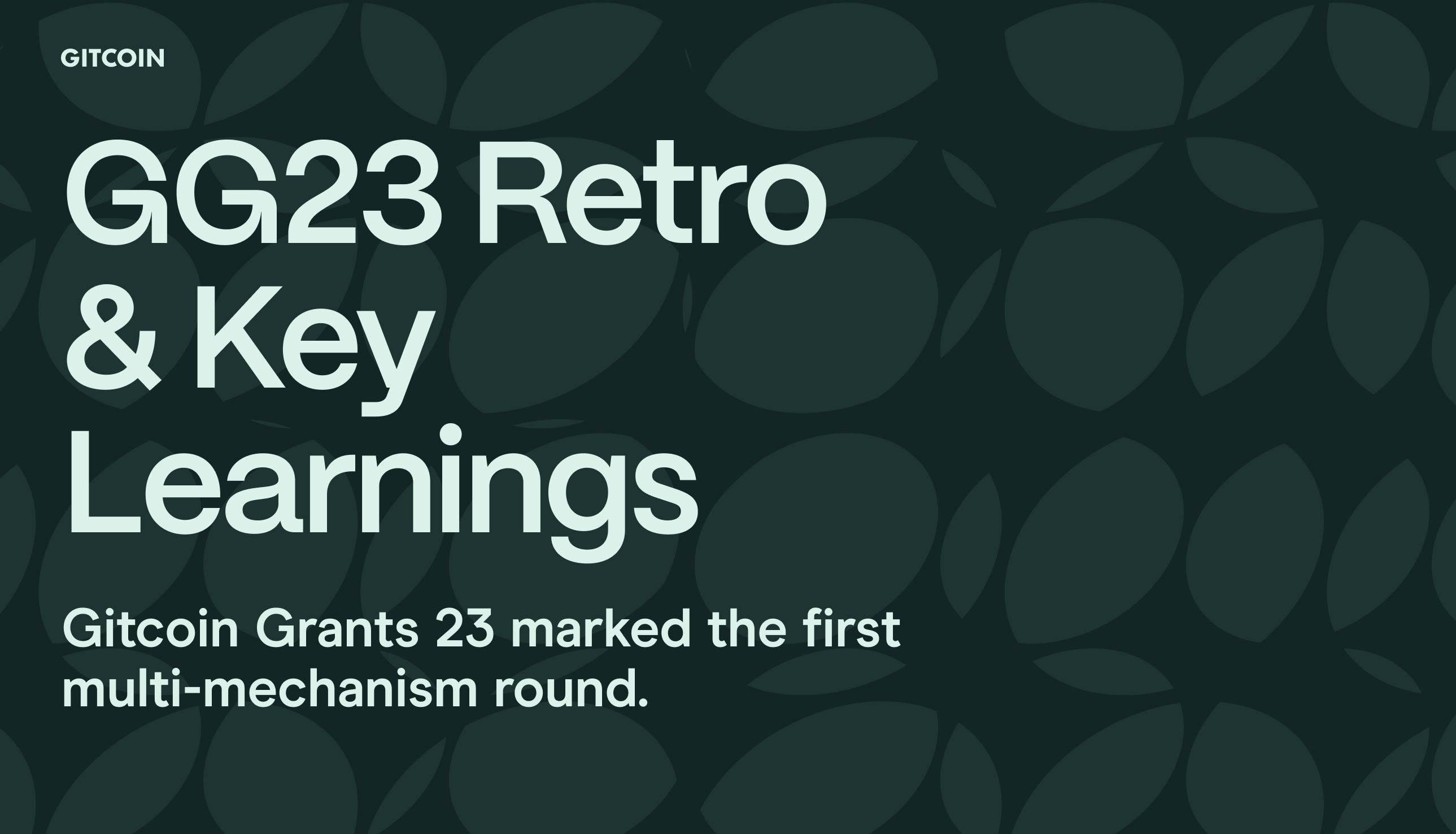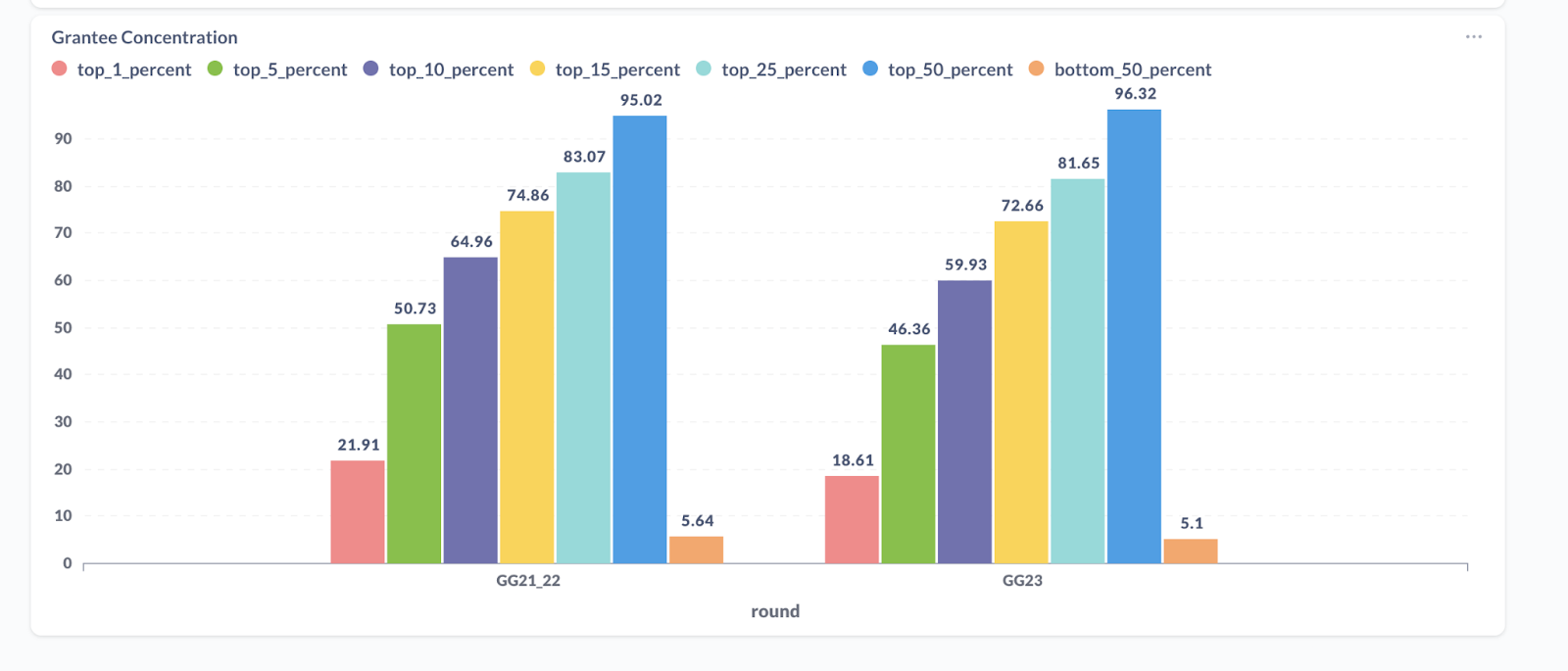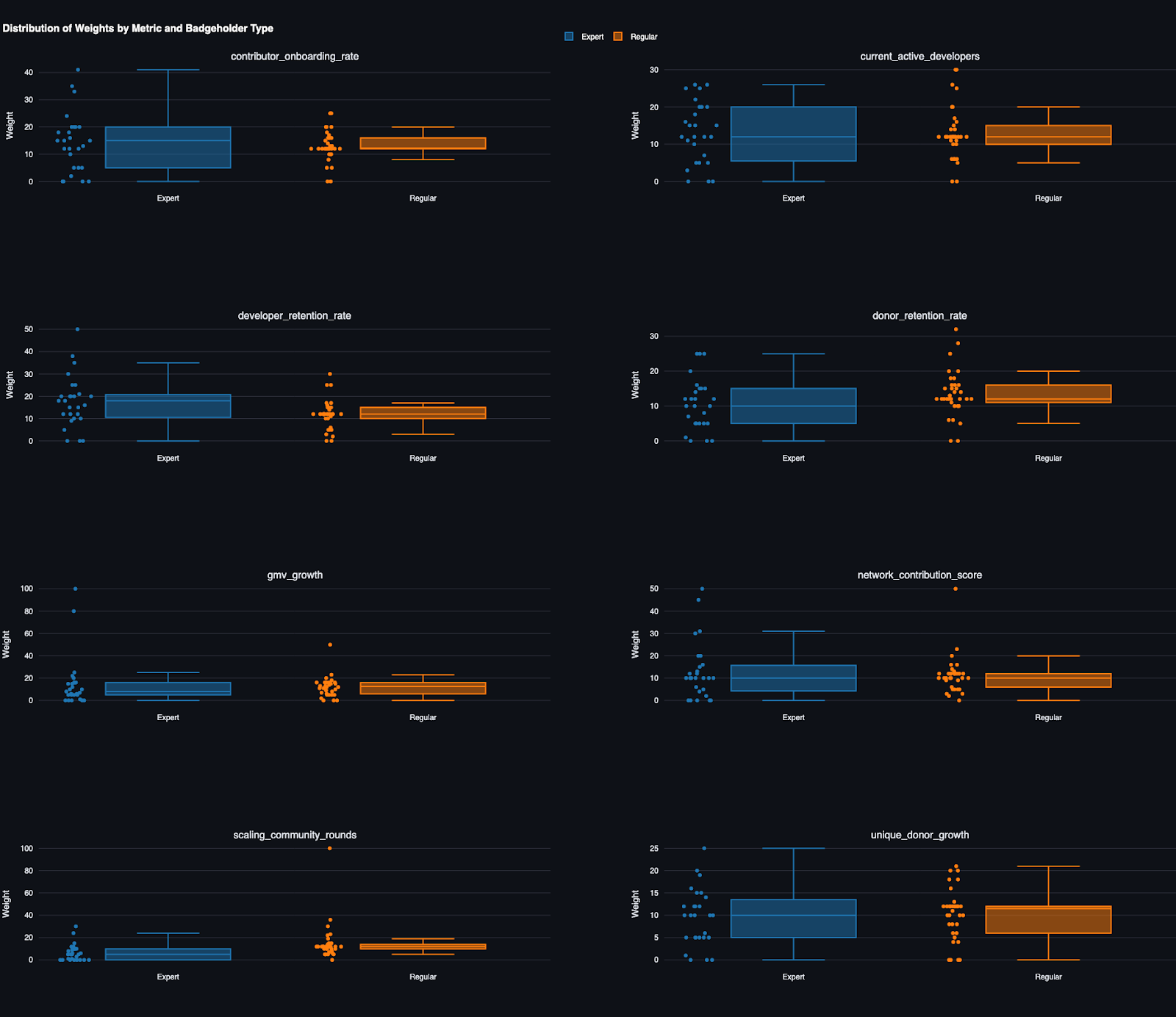Gitcoin Grants 23: A Milestone Round for Public Goods Funding

GG23 was Gitcoin’s most comprehensive experiment yet, distributing over $1.3M through Quadratic and Retro Funding simultaneously. It tested Gitcoin’s evolving governance and funding stack at scale—introducing GTC staking, badgeholder voting, and a redesigned onboarding experience.
Gitcoin Grants 23 (GG23) was our most ambitious and multi-faceted round to date. For the first time, we ran Quadratic Funding (QF) and Retroactive Funding (RF) side by side at scale—distributing over $1.3 million to public goods projects across the ecosystem. We also had the most amount of Community Round applications.
GG23 was so much more than just another grants round, it was also a stress test of Gitcoin’s evolving funding stack: governance design and data-driven evaluation. From GTC staking and badgeholder voting to new onboarding models, this round forced us to rethink what’s possible, what helps, and what hurts when communities fund what matters.
We’ve walked away from GG23 with mountains of learnings on both the early-stage discovery power of QF and the maturity-weighted precision of Retro Funding, and have identified key stats, behavioral insights, technical progress, and lessons that will shape Gitcoin’s future as the coordination layer for ecosystem-scale capital coordination.
TL;DR Highlights
- $1.3M+ distributed across QF and RF rounds, and Community Rounds
- 235 OSS projects funded via QF; 30 funded via Retro
- 9,991 unique donors contributed $95K+ in OSS QF rounds
- GTC staking and badgeholder voting piloted across both mechanisms
- GMV growth emerged as the top predictor of RF outcomes
- Community Rounds were governed through a new platform, Grant Ships
- Key takeaway: Multi-mechanism funding works, but clarity, alignment, and contributor support are critical
Quadratic Funding: Powering Early-Stage Builders
The Quadratic Funding side of GG23 continued Gitcoin’s commitment to funding early-stage builders through a mechanism that rewards community signals. Across three thematic categories, including Web3 Infrastructure, Developer Tooling & Libraries, and dApps & Apps, over $600,000 in matching funds were distributed to 235 projects, fueled by nearly 10,000 unique donors contributing $95,000+ in crowdfunding.
GG23 introduced several meaningful improvements: from a GTC staking experiment to a dedicated onboarding team for grantees. These additions helped QF rounds scale with stronger integrity, and more inclusive access for first-time participants.
This retrospective surfaces insights from QF round design, participation patterns, and experiments aimed at deepening legitimacy and accessibility.
Donor Behavior & Distribution Patterns
Compared to the Retro Funding round, funding in QF was more evenly distributed across projects. Community members tended to reward clear utility and practical tooling, especially those with reputational weight or demonstrated traction.
The top 10% of QF grantees captured ~45% of total matching funds—lower concentration than retro, but still non-trivial.
This suggests that QF rounds, while subject to attention dynamics, do reflect broader contributor consensus. Unlike Retro Funding, where top badgeholders drove decisions, QF gave more power to individual donors, resulting in more distributed outcomes.

Participation & Community Engagement
QF also gave us a real-time look at community interest across builder categories:
- Tooling drew support from developers and downstream integrators
- dApps resonated most with mission-aligned end users
- Infra projects benefited from reputation and ecosystem necessity
The Gitcoin-funded Let’s Grow DAO onboarding initiative played a key role here, supporting grantees with 1:1 guidance and education. It ensured smaller teams could meaningfully participate and minimized drop-off among less-experienced applicants.

Experimental Design & Sybil Defense
GG23 also marked consistency in sybil resistance:
- Connection-Oriented Cluster Matching (COCM) reduced overfitting and rewarded broader support
- Passport’s model-based detection flagged potential sybil patterns without user friction
- These approaches gave us our strongest QF results to date in terms of legitimacy and trust
Additionally, a GTC staking pilot allowed users to express preference across rounds, adding an incentive-aligned meta-layer to donor activity.
Retro Funding: Rewarding Proven Impact
The GG23 Mature Builders Retro Funding round marked a significant milestone for Gitcoin. As our second major experiment with retroactive public goods funding at scale, GG23 allocated over $600,000 across 30 projects leveraging our badgeholder voting mechanism. This round was designed to reward impact that had already been delivered in a way that was grounded in data and enriched by human judgment.
TL;DR
- GMV growth emerged as the strongest predictor of funding, signaling an alignment toward economic traction.
- Expert badgeholders showed more variance in metric preferences than Regulars, suggesting a need for clearer metric guidance.
- Cluster analysis revealed equitable funding across four distinct project types, from breakout stars to early-stage experiments.
- Community feedback pointed to progress in staking, onboarding, and tooling — but highlighted lingering pain points in engagement, data visibility, and eligibility.
Funding Behavior: Growth, Retention, and Power Laws
We analyzed how different project metrics influenced final allocations. The most influential metric? GMV growth. Both correlation and feature importance models confirmed that projects showing strong economic traction were rewarded by badgeholders.
Following GMV were metrics like current_active_developers, contributor_onboarding_rate, and donor_retention_rate — all indicators of sustained project health. While encouraging, these results surfaced a persistent challenge: concentration**.**
The top 10% of grantees received ~60% of total GG23 funding. The top 1% received nearly 1/5.
This follows a long-standing pattern in public goods rounds, where a small group of standout projects dominate attention and allocations. Whether this reflects merit or momentum, it points to a need for better support mechanisms for mid-tier and emerging builders.

Who Votes, How They Vote, and Why It Matters
The round included 61 badgeholders, split into Expert and Regular cohorts. Analysis of their voting behavior revealed:
- Experts showed greater variance and less consensus, with wide spreads across metrics
- Regulars showed stronger alignment, clustering tightly around a few shared priorities
- Experts tended to weight onboarding- and growth-related metrics higher
- Regulars leaned toward retention metrics like developer and donor retention
This division suggests value in engaging both groups: Experts for their diverse insights and edge-case awareness, Regulars for consistency and signal strength. A mixed cohort approach appears critical for resilient governance.

Cluster Insights: Four Paths to Impact
Using cluster analysis, we grouped the 30 projects into four archetypes:
- Stable Infrastructure (e.g., Giveth, Blockscout): Moderate growth, strong developer bases, consistent engagement
- Loyal Donor Base (e.g., EthStaker, Poapin): Fewer devs, but very high donor retention rates
- Breakout Growth (e.g., L2BEAT, DefiLlama): High GMV growth, wide reach, largest grants
- Early-Stage Experiments (e.g., POAPin, Beacon Chain): Smaller teams, lower funding, but emerging potential
Despite their differences, each cluster received a similar share of total funds, showing Gitcoin’s commitment to funding a broad spectrum of public goods work — not just market leaders.

What We’re Taking Into GG24
Across product feedback sessions, user interviews, and post-round reflections, the community shared a clear and nuanced picture of what’s working—and what still needs refinement.
What’s Working:
- High-quality OSS applications across both RF and QF rounds
- Staking was popular and easy to use, helping voters and donors signal support
- Onboarding, email comms, and appeals support were well received, especially among Retro participants
- Sybil resistance improvements (Passport + COCM) increased trust in QF outcomes
- Grantee support from Let’s Grow DAO was a major boost for first-time participants in QF rounds
What’s Hurting:
- Retro Funding goals were unclear to many voters, especially around what qualified as “impact”
- Low badgeholder engagement limited voter diversity in RF
- Donor friction in QF, especially around matching rules, Passport use, and checkout UX
- Eligibility and verification issues (e.g., GitHub linking, multi-sig limitations) created confusion
- Lack of data visibility made it hard for voters and donors to evaluate projects across both mechanisms
And Where We Can Grow:
- Make staking more constructive, with clearer links between staked support and outcomes
- Differentiate grant paths more explicitly (e.g., separate RF and QF tracks for regen vs infra vs apps)
- Clarify eligibility and round goals early and often—with built-in product nudges
- Improve discovery and matching UX for donors, especially in larger QF rounds
- Enable richer voting/donation signals, like project tagging, rubric surfacing, and feedback metadata
What’s Next
As we look toward GG24, this round has given us the clearest view yet into how grantees behave, how voters think, and how capital flows. It has also exposed the levers we can pull to create a more inclusive, transparent, and adaptive funding environment.
Key priorities include:
- Strengthening re-engagement pathways for high-potential grantees
- Balancing metric clarity with voter flexibility
- Tracking retention and concentration as ongoing KPIs
- Designing better UX around staking, minting, and feedback
As we move into the Gitcoin 3.0 era, we will take the above learnings and adapt them to the new structure we’ll be entering into through Dedicated Domain Allocation, as outlined in this post.
Let’s keep building that world, together.
